Everything 9th grade biology 2.0
1/218
There's no tags or description
Looks like no tags are added yet.
Name | Mastery | Learn | Test | Matching | Spaced |
|---|
No study sessions yet.
219 Terms
Energy Pyramid
A diagram showing the amount of energy available at each trophic level in an ecosystem.
Material Cycles in Ecosystems
The recycling of materials such as carbon, nitrogen, and water in an ecosystem.
Biomass
The total mass of living organisms in an ecosystem.
Combustion/Cellular Respiration
The process by which cells break down food to release energy.
Cell
The basic unit of life.
Decomposition
The breakdown of dead organisms and waste materials by decomposers.
Food Chain
A linear sequence of organisms where each one is eaten by the next.
Food Web
A complex network of interconnected food chains.
Ecosystem Services
The benefits that ecosystems provide to humans, often without us realizing it.
Population
A group of individuals of the same species living in the same area.
Niche
The role or function of an organism in its environment.
Biodiversity
The variety of different species in an ecosystem.
Bioaccumulation of Environmental Toxins
The buildup of toxins in organisms, especially at higher trophic levels.
Sustainable Development
Development that meets the needs of the present without compromising future generations.
Abiotic Environment
The non-living components of an ecosystem, such as water and air.
Biotic Environment
The living components of an ecosystem, including plants and animals.
What is an ecosystem?
An ecosystem is a dynamic community of living organisms (biotic factors) interacting with each other and with non-living components (abiotic factors) such as water, soil, air, and climate in a defined area. These interactions can be complex, with organisms relying on each other for food, shelter, and reproduction. Ecosystems can vary widely in size and can include habitats like forests, deserts, wetlands, and coral reefs. They are crucial for maintaining biodiversity and ecological balance.

What is an energy pyramid, and why is there energy loss between trophic levels?
An energy pyramid illustrates how energy flows from producers to consumers, with approximately 90% of energy lost as heat during each transfer due to metabolic processes.
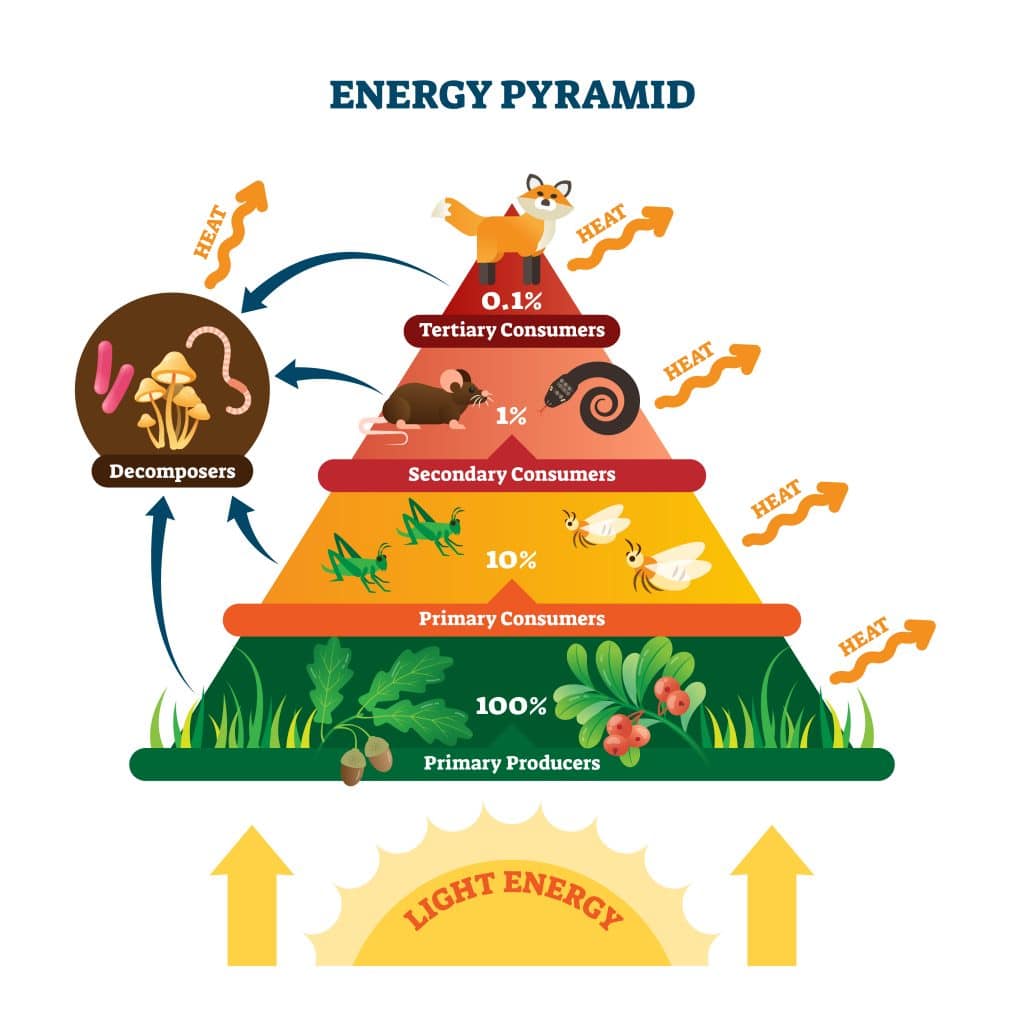
What happens if one level in an energy pyramid is disrupted?
1. If one level in the energy pyramid is disrupted, the levels above it receive less energy and food.
2. For example, if producers decrease, primary consumers have less to eat, causing their population to shrink.
3. This leads to fewer secondary consumers, weakening the entire food chain.
What are biogeochemical cycles in an ecosystem?
Biogeochemical cycles are cycles that recycle matter through an ecosystem, including the water, carbon, nitrogen, phosphorus, and sulfur cycles.

Define biomass and explain its significance.
Biomass is the total mass of living organisms in a specific area, reflecting the productivity and potential energy available to support higher trophic levels.
How does cellular respiration complement photosynthesis?
Cellular respiration converts glucose and oxygen into energy, releasing carbon dioxide and water, effectively reversing the process of photosynthesis.
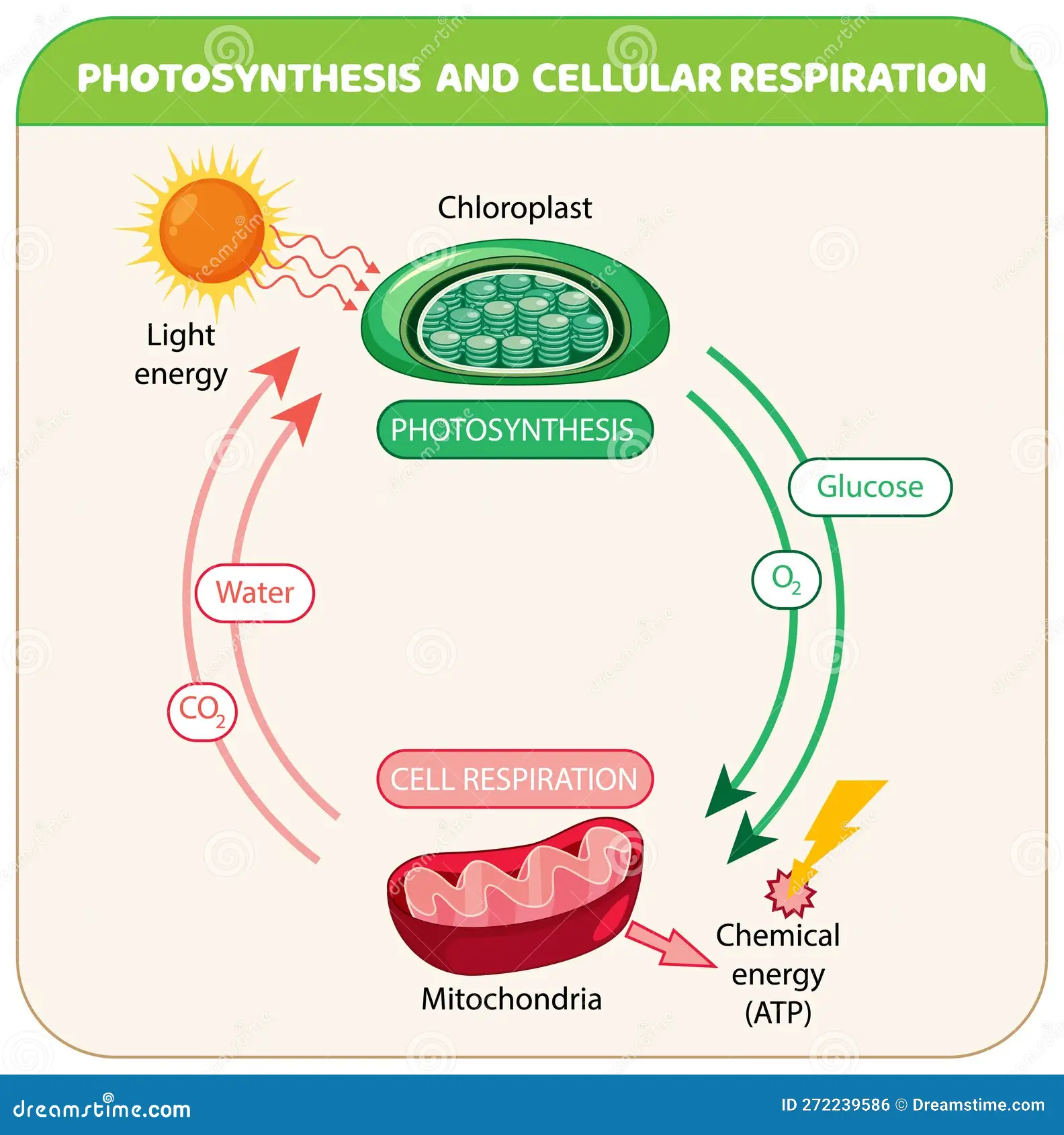
What role does the cell play in living organisms?
The cell is the basic unit of life where all vital processes occur, sustaining the organism.
What is decomposition and why is it important?
Decomposition is the breakdown of dead organic matter by decomposers, recycling nutrients back into the ecosystem.
What is the difference between a food chain and a food web?
A food chain is a linear sequence of organisms consumed one after the other, while a food web is a complex network of interconnected food chains.
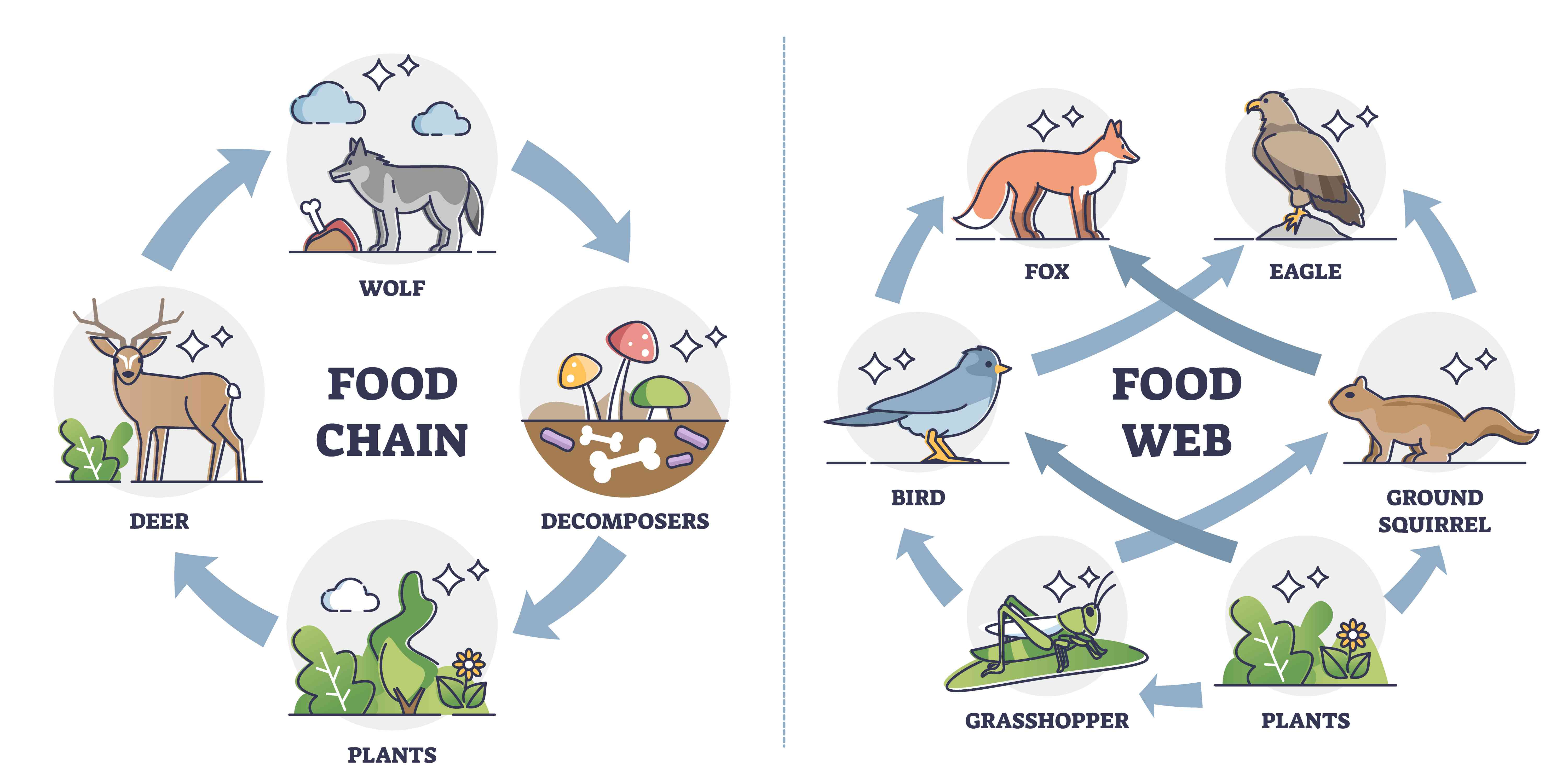
What are ecosystem services?
Ecosystem services are the benefits humans derive from ecosystems, including clean water, air purification, pollination, and climate regulation.
What is a population in ecological terms?
A population is a group of individuals of the same species living in a defined area, influenced by factors like birth, death, and migration.
Define an ecological niche.
An ecological niche is the role or position a species occupies in its environment, including its habitat, resource use, and interactions with other organisms.
What does biodiversity mean?
Biodiversity is the variety of life in an ecosystem, encompassing species diversity, genetic diversity, and ecosystem diversity.
What is biomagnification, and why is it a concern?
Biomagnification is the accumulation of environmental toxins at higher concentrations in organisms at higher trophic levels, posing risks to health and ecosystem stability.
What is sustainable development in an ecological context?
Sustainable development means managing natural resources to meet current human needs without compromising future generations' ability to meet theirs.
What is the difference between abiotic and biotic environments?
Abiotic environments are non-living physical and chemical components, while biotic environments consist of all living organisms in an ecosystem.
Differences Between Plant and Animal Cells:
1. Cell Wall:
• Plant cells have a cell wall for extra support and structure.
• Animal cells do not have a cell wall.
2. Chloroplasts:
• Plant cells contain chloroplasts for photosynthesis.
• Animal cells do not have chloroplasts.
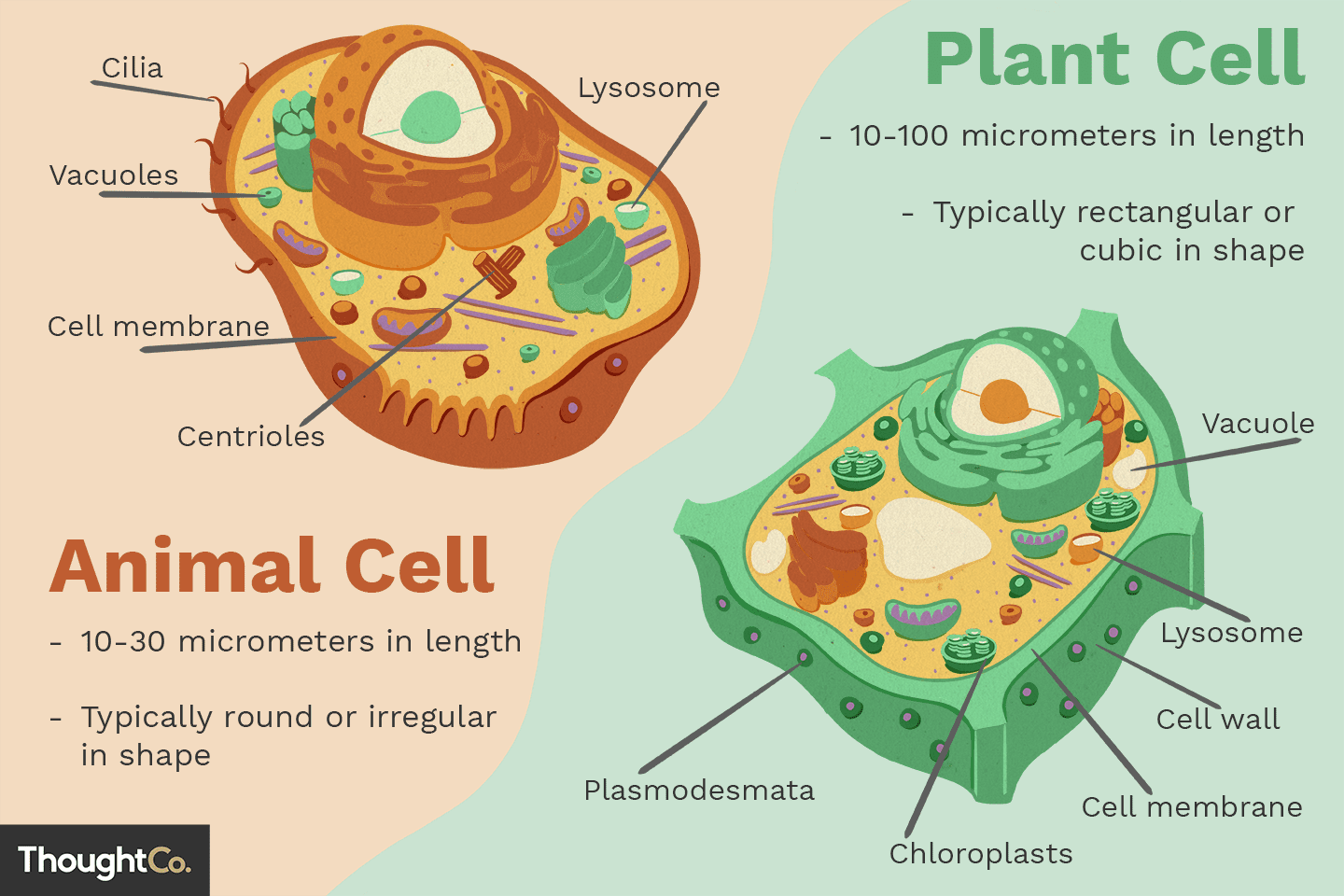
Similarities Between Plant and Animal Cells:
1. Nucleus:
• Both plant and animal cells have a nucleus, which contains the cell’s genetic material (DNA).
2. Mitochondria:
• Both plant and animal cells have mitochondria, which provide energy to the cell.
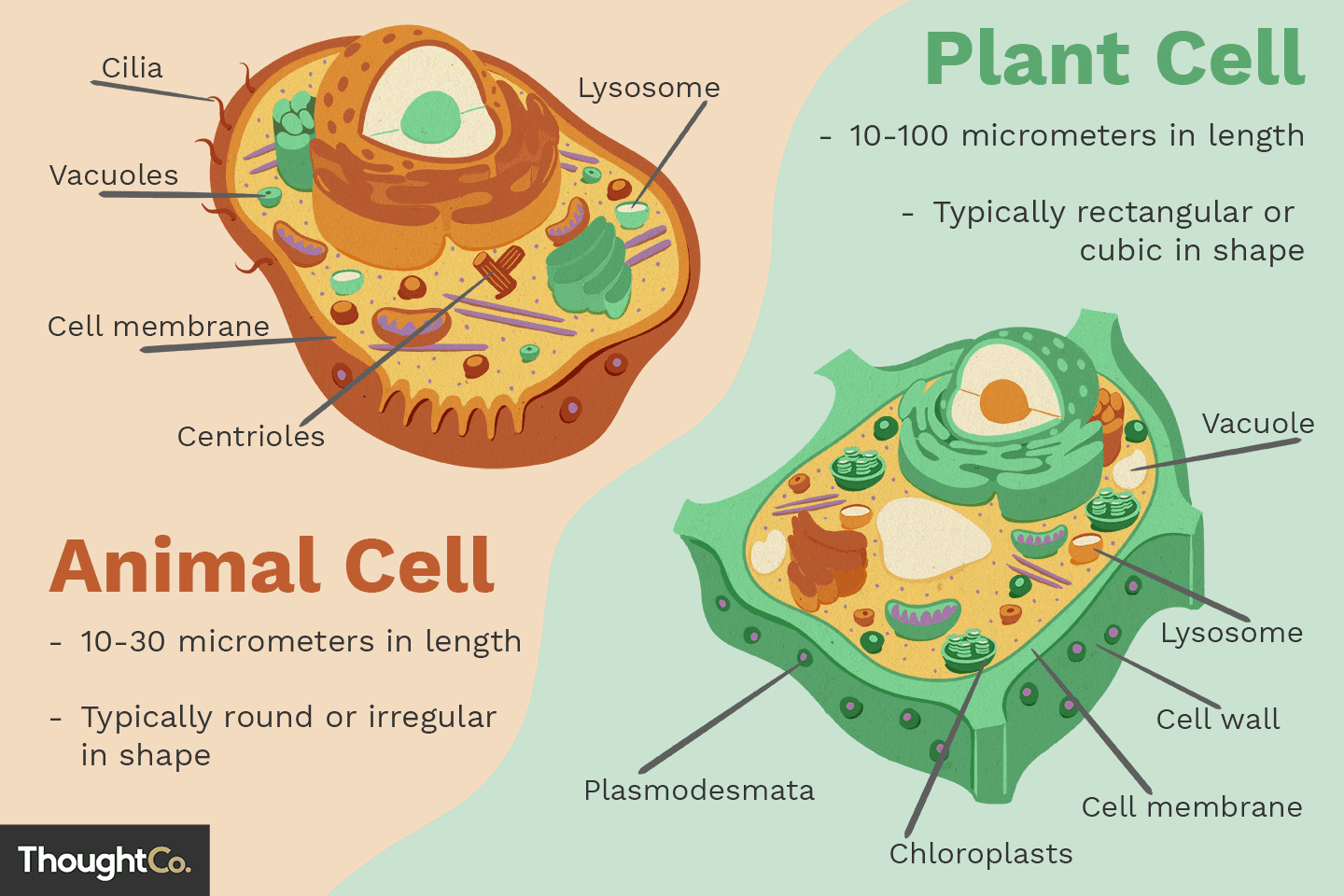
What is a Mitochondrion?
• The mitochondrion (plural: mitochondria) is an organelle in both plant and animal cells.
• It is known as the “powerhouse” of the cell because it generates energy in the form of ATP (adenosine triphosphate) through a process called cellular respiration.
• Mitochondria have their own DNA and can replicate, which makes them unique among other cell organelles.
What is human anatomy?
The study of the structure of the body and its organs, and how they work together to maintain function.
What are stem cells, and why are they important?
Stem cells are unspecialized cells capable of developing into various cell types, playing a key role in growth, tissue repair, and replacing damaged cells.
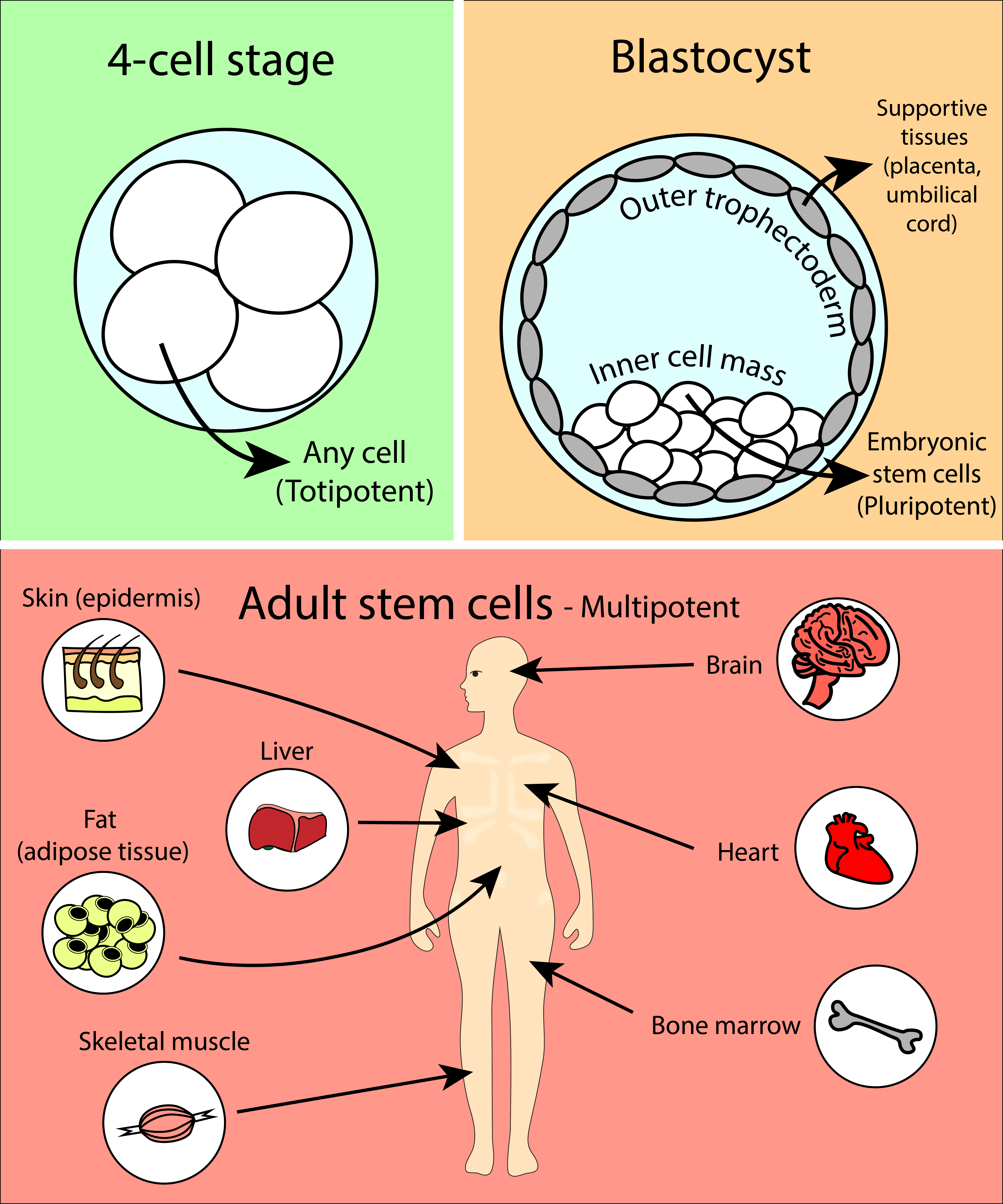
Lab Report Structure or Lab Planning Template.
1. Title
A short name for the experiment.
Start with:
• “The effect of…”
• “How [something] affects [something else]”
• Example: The effect of light on plant growth
2. Aim
What you want to find out.
Start with:
• “To investigate…”
• “To find out the effect of…”
• Example: To investigate the effect of light on how fast plants grow
3. Hypothesis
Your guess about what will happen and why.
Start with:
• “If…, then…”
• “I think that…”
• Example: If a plant gets more light, then it will grow taller
4. Materials
A list of things you need.
Use bullet points:
• Soil
• 3 pots
• Water
• Ruler
• Seeds
• Lamp
5. Method
Steps to do the experiment.
Start each step with a number:
1. Fill the pots with soil
2. Plant a seed in each pot
3. Put them in different light conditions
4. Water them every day
5. Measure the height daily for 7 days
6. Variables
Write like this:
• Independent variable (what you change): amount of light
• Dependent variable (what you measure): plant height
• Controlled variables (what stays the same): type of seed, soil, water, pot size
7. Results
What you saw or measured.
Use a table, graph, or describe what happened
Example:
“The plant in the sun grew to 10 cm, the one in shade grew to 7 cm, and the one in dark grew to 3 cm.”
8. Conclusion
What you learned. Say if your guess was correct.
Start with:
• “The results show that…”
• “This supports / does not support my hypothesis because…”
Example: The results show that more light made the plant grow taller. This supports my hypothesis.
9. Evaluation
Think about how the experiment went.
Include:
• Was it fair?
• Any problems?
• How can you improve it?
Example: It was mostly fair, but one plant got less water by mistake. Next time, I would use a measuring cup to give equal water.
Example lab report
Sure! Here’s a simpler version of an A-level 9th-grade lab report while keeping it detailed and structured.
Title
The Effect of Light Intensity on Photosynthesis
Aim
To investigate how light intensity affects the rate of photosynthesis in an aquatic plant.
Hypothesis
If the light intensity increases, the rate of photosynthesis will also increase because more light energy is available for the plant. However, at a certain point, other factors (like CO₂ or temperature) may limit the rate.
Materials
• 500 mL beaker
• Water
• Sodium bicarbonate (adds CO₂)
• Aquatic plant (e.g., Elodea)
• Lamp
• Ruler
• Stopwatch
Method
1. Fill the beaker with water and add sodium bicarbonate.
2. Place the aquatic plant inside the beaker.
3. Position the lamp 10 cm from the beaker.
4. Turn on the lamp and start the stopwatch.
5. Count the number of oxygen bubbles the plant produces in one minute.
6. Repeat steps at 20 cm, 30 cm, and 40 cm distances.
7. Record the results in a table.
8. Repeat each test three times for accuracy.
Variables
• Independent Variable: Distance of the lamp (light intensity)
• Dependent Variable: Number of oxygen bubbles per minute
• Controlled Variables: Water temperature, CO₂ levels, type of plant, duration of test
Results
Distance from Lamp (cm) | Bubbles per Minute (Trial 1) | Trial 2 | Trial 3 | Average Bubbles per Minute |
10 cm | 20 | 22 | 18 | 20 |
20 cm | 14 | 16 | 15 | 15 |
30 cm | 9 | 11 | 10 | 10 |
40 cm | 5 | 6 | 5 | 5 |
A graph can also be included, showing the trend.
Conclusion
The results support the hypothesis: the closer the light, the more photosynthesis occurs, as seen in the higher oxygen bubble count. However, at greater distances, photosynthesis slowed down due to less light energy reaching the plant.
Evaluation
• Reliability: The test was repeated three times, making it more accurate.
• Potential Errors:
• Some bubbles may have been too small to count properly.
• Light might not have been evenly distributed.
• Improvements:
• Using a gas syringe instead of counting bubbles would provide more precise measurements.
• Testing at more distances (e.g., 15 cm, 25 cm) would give a more detailed trend.
This version is simpler but still A-level, with a clear structure, logical flow, and a thoughtful evaluation. Would you like any further simplifications?
Tips for writing a lab report
Understand the Structure First
• Think of a lab report as a story: What are you testing? How do you test it? What happens? What does it mean?
• Read through past lab reports or examples (like the one I gave) to get familiar with the structure.
2. Use Mnemonics or Flashcards
• Make flashcards with each section (Title, Aim, Hypothesis, etc.) and a short explanation.
• Example:
• Hypothesis → “Prediction based on science.”
• Method → “Step-by-step instructions to repeat the experiment.”
3. Focus on Key Concepts Instead of Memorizing Everything
• You don’t need to memorize entire experiments, just understand how they are structured.
• Practice identifying independent, dependent, and controlled variables in different experiments.
4. Practice Writing Short Reports
• Start with simple experiments, like “Does sugar dissolve faster in hot or cold water?”
• Use a template and fill in the sections step by step.
5. Review and Learn from Feedback
• If you get teacher feedback, go through it carefully and improve one section at a time.
What are the main functions of cells in the body?
Cells take in nutrients and oxygen to produce energy, excrete waste, communicate with other cells, and support growth and repair processes.
What are the two types of digestion?
Mechanical digestion involves the physical breakdown of food, while chemical digestion uses enzymes to break down food into smaller molecules.
What happens in the mouth during digestion?
In the mouth, digestion begins:
1. Teeth break food into smaller pieces (mechanical digestion).
2. Saliva contains amylase, which starts breaking down starch (chemical digestion).
3. The tongue pushes food (bolus) into the esophagus for swallowing.
What is the role of the stomach?
The stomach mechanically churns food and uses stomach acid and enzymes to chemically break down proteins, beginning the digestion of fats and turning proteins into amino acids.
The stomach breaks down food by:
1. Churning muscles in the stomach wall contract and relax in a wave-like motion to mix the food (mechanical digestion).
2. Releasing gastric acid to kill bacteria and break down proteins (chemical digestion).
3. Producing enzymes like pepsin to digest proteins.
4. Sending partially digested food (chyme) to the small intestine.
What happens in the upper intestine?
digestion and nutrient absorption occur with the help of pancreatic enzymes and bile.
1. Enzymes break down food – Pancreatic enzymes and bile help digest carbohydrates, proteins, and fats.
2. Nutrient absorption – The intestinal walls absorb nutrients into the bloodstream.
3. Transport to cells – Nutrients travel through the blood to be used for energy and growth.
What happens in the small intestine?
Enzymes from the pancreas and bile continue breaking down food, and nutrients are absorbed into the blood through villi. 1. Enzymes continue digestion – Pancreatic enzymes and bile break down food further.
2. Nutrient absorption – Villi and microvilli absorb nutrients into the bloodstream.
3. Waste moves forward – Undigested food is pushed toward the large intestine.
What is the function of the large intestine?
1. Water absorption – Removes water from waste to prevent dehydration.
2. Vitamin production – Gut bacteria produce vitamins like vitamin K.
3. Waste formation – Compacts undigested food into feces for elimination.
What is the function of the gallbladder?
The gallbladder stores and concentrates bile produced by the liver, releasing it into the small intestine to aid in the digestion of fats.
How do enzymes help in digestion?
Enzymes break down complex molecules into simpler ones, such as carbohydrates into glucose, proteins into amino acids, and fats into glycerol and fatty acids.
What does bile do in digestion?
Bile emulsifies fats, breaking them down into smaller droplets for easier digestion.
What is the function of the respiratory system?
The respiratory system brings oxygen into the body and removes carbon dioxide, which is essential for cellular respiration.
How does gas exchange work in the lungs?
Oxygen diffuses from the air in the alveoli into the blood, while carbon dioxide diffuses from the blood into the alveoli to be exhaled.
What role do red blood cells play in respiration?
Red blood cells transport oxygen from the lungs to tissues throughout the body using hemoglobin.
Haemoglobin
Hemoglobin is a protein in red blood cells. It carries oxygen from the lungs to the rest of the body and helps bring carbon dioxide back to the lungs to be exhaled.
What is the function of the circulatory system?
The circulatory system transports oxygen, nutrients, hormones, and waste products throughout the body.
How is the heart structured?
The heart has four chambers: two atria and two ventricles, with valves to prevent backflow of blood.
What are the two circulatory loops?
Pulmonary circulation moves blood from the heart to the lungs, while systemic circulation supplies oxygen-rich blood to the rest of the body.
What are the three types of blood vessels and their functions?
Arteries carry oxygen-rich blood away from the heart, veins carry deoxygenated blood back to the heart, and capillaries allow gas and nutrient exchange.
What are the main components of blood?
Red blood cells transport oxygen, white blood cells fight infection, platelets help with clotting, and plasma transports nutrients and waste.
How do white blood cells protect the body?
White blood cells detect and destroy pathogens like bacteria and viruses, helping to protect against infections.
Excretion
Excretion is the process by which the body removes waste products. It involves the kidneys filtering blood to remove excess water, salts, and waste, which is then expelled as urine. The body also excretes waste through sweat and carbon dioxide when breathing.
Kidneys
The kidneys are two bean-shaped organs that filter waste products from the blood, regulate fluid and electrolyte balance, and produce urine. They also help maintain blood pressure and produce hormones that regulate red blood cell production and calcium levels.
Skin
The skin is the body’s largest organ. It protects internal organs, helps regulate body temperature through sweating and blood flow, and acts as a barrier against harmful microorganisms. It also allows for the sense of touch and produces vitamin D when exposed to sunlight.
Sweat
Sweat is a fluid produced by sweat glands in the skin. It helps regulate body temperature by cooling the body as it evaporates from the skin’s surface. Sweat also contains waste products like salts and urea, which are excreted through the skin.
What is the main function of the nervous system?
The nervous system controls and coordinates body activities by transmitting electrical signals through the brain and nerves.
How do muscles work with bones to move the body?
Muscles contract to pull on bones, causing movement, and work in opposing pairs.
What is the primary function of the nervous system?
The nervous system coordinates and regulates bodily functions by transmitting electrical and chemical signals between different parts of the body.
What are the five traditional senses?
The five traditional senses are sight, hearing, taste, touch, and smell.
How does the eye contribute to vision?
The eye detects light and converts it into electrical signals, which are processed by the brain to form visual images.
What is the role of the ear in hearing and balance?
The ear captures sound vibrations for hearing and contains structures that help maintain bala
How do taste buds function?
Taste buds contain sensory receptors that identify flavors such as sweet, sour, salty, bitter, and umami, sending signals to the brain for taste perception.
How does the sense of touch work?
Receptors in the skin respond to pressure, temperature, and pain, sending signals to the brain to interpret tactile sensations.
What is the olfactory system responsible for?
The olfactory system detects airborne chemicals, allowing the perception of odors.
What is proprioception?
Proprioception is the sense of the relative position of one’s own body parts and strength of effort being employed in movement.
How does the brain process sensory information?
Sensory information is received by specialized receptors, transmitted via neurons to specific brain regions, where it is interpreted to form perceptions.
What are neurons?
Neurons are specialized cells that transmit nerve impulses, serving as the fundamental units of the brain and nervous system.
What is the difference between the central nervous system (CNS) and the peripheral nervous system (PNS)?
The CNS consists of the brain and spinal cord, processing and integrating information, while the PNS includes all neural elements outside the CNS, connecting it to the rest of the body.
What role do sensory neurons play in the nervous system?
A: Sensory neurons respond to external stimuli and send signals to the brain and spinal cord, enabling perception of sensory information.
What is the function of the cerebellum?
The cerebellum coordinates voluntary movements, maintains posture, and ensures balance and motor control.
Describe the role of the spinal cord in the nervous system.
The spinal cord transmits neural signals between the brain and the rest of the body, facilitating reflex actions and sensory processing.
How does the brainstem contribute to bodily functions?
The brainstem controls vital functions such as heart rate, breathing, and sleep, acting as a conduit for signals between the brain and spinal cord.
What are the four main blood types?
A, B, AB, and O.
What blood types can O-positive (O+) receive?
O+ and O- (it has Rh factor but no A or B antigens).
What is the rarest blood type?
AB-negative (AB-).
What is the most common blood type?
O-positive (O+).
What determines a person’s blood type?
The presence or absence of A and B antigens on red blood cells.
What is the Rh factor?
A protein found on red blood cells. If present, the blood type is positive (+); if absent, it is negative (-).
Which blood type is the universal donor?
O-negative (O-) because it has no A, B, or Rh antigens, so it won’t trigger an immune response.
Why is blood type important in transfusions?
If the wrong blood type is given, the immune system attacks the transfused blood, causing a dangerous reaction.
Which blood type can receive only its own type?
O-negative (O-), since it has no A, B, or Rh antigens but has antibodies against all other types.
What is antibiotic resistance?
Antibiotic resistance occurs when bacteria evolve to become resistant to the drugs designed to kill them, making infections harder to treat.
How do bacteria become resistant to antibiotics?
Bacteria can become resistant through mutations or by acquiring resistance genes from other bacteria. These bacteria survive antibiotic treatment and multiply, spreading resistance.
Why is antibiotic resistance a global problem?
Antibiotic resistance means bacteria survive antibiotics. This leads to infections that are harder to treat, requiring stronger, more expensive medications. This causes longer illness, higher medical costs, and can increase the risk of death. As resistance spreads, more infections become untreatable, putting both individual and public health at risk.
How can antibiotic resistance be prevented?
A: Use antibiotics only when prescribed, finish the full course, avoid using antibiotics for viral infections, and reduce antibiotic use in agriculture.
What is a vaccine?
A vaccine is a biological preparation that stimulates the immune system to recognize and fight specific (bacteria or viruses).
How do vaccines work?
Vaccines introduce weakened or inactive bacteria or viruses (or parts of them) to the body, which prompts the immune system to produce antibodies and “remember” how to fight the pathogen.
Why are vaccines important?
Vaccines prevent serious diseases, protect individuals and communities, reduce healthcare costs, and help eliminate or control diseases globally.
How do vaccines help with antibiotic resistance?
Vaccines prevent infections, which reduces the need for antibiotics, helping to slow down the development of antibiotic resistance.
Common diseases
Infectious Diseases
• Flu – Viral infection causing fever, cough, and fatigue.
• Common Cold – Mild viral illness with sneezing and sore throat.
• COVID-19 – Respiratory infection caused by SARS-CoV-2.
• Tuberculosis (TB) – Bacterial lung infection.
• Malaria – Mosquito-borne disease causing fever and chills.
Non-Infectious Diseases
• Diabetes – High blood sugar due to insulin problems.
• Asthma – Breathing difficulty due to inflamed airways.
Genetic & Autoimmune Diseases
• Cystic Fibrosis – Genetic disease affecting lungs and digestion.
• Multiple Sclerosis (MS) – Nerve disease caused by immune attacks.
• Lupus – Autoimmune disease affecting multiple organs.
What is homeostasis?
Homeostasis is the process by which the body maintains a stable internal environment.
What is puberty?
The stage of development where the body matures sexually, triggered by hormones like testosterone and estrogen.